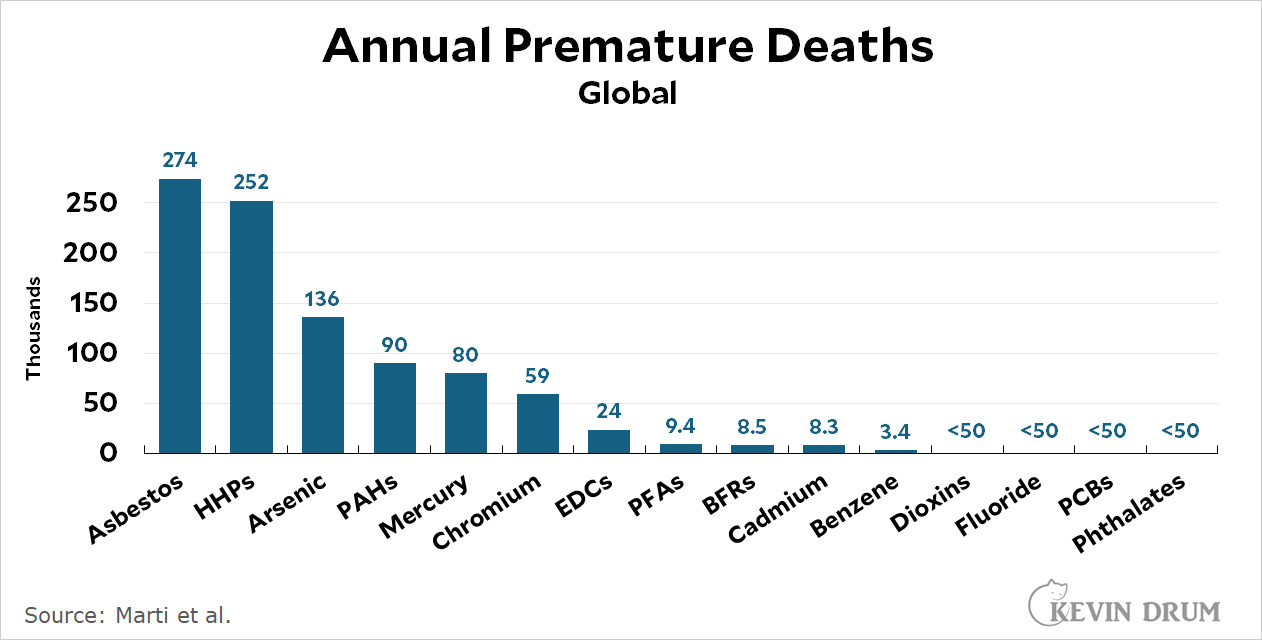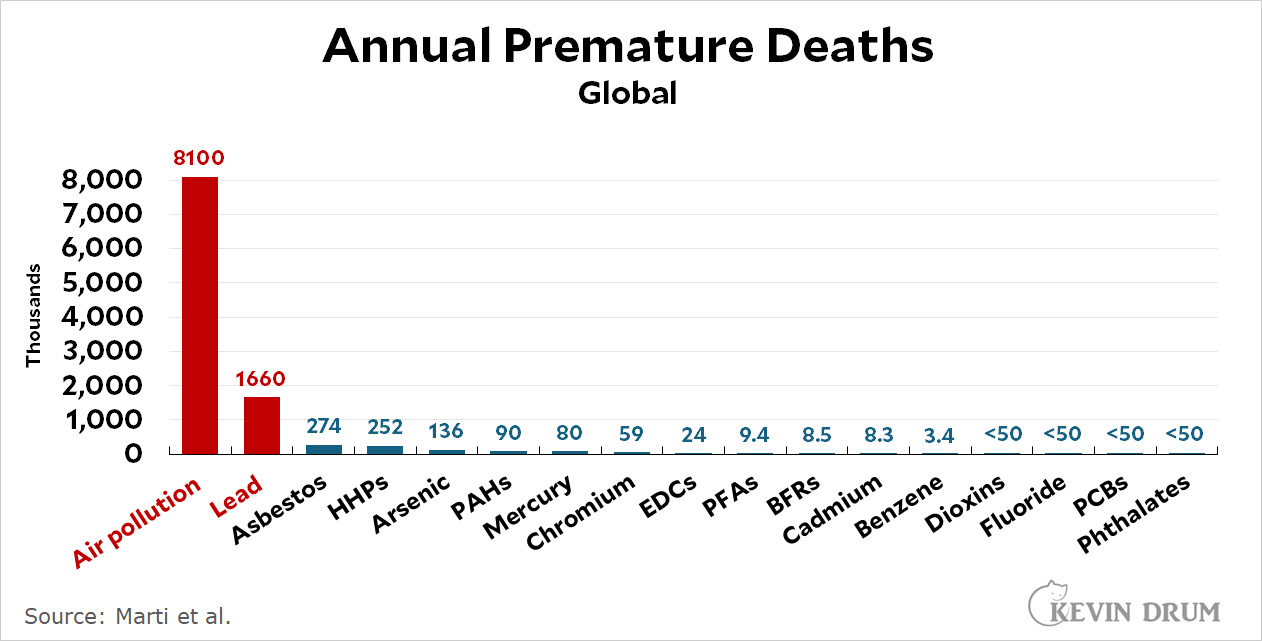According to a new study, here's our best estimate of the number of premature deaths caused each year by a variety of chemicals:
 But wait! I left the two biggest killers off because they wrecked the y-axis. Here's the full chart:
But wait! I left the two biggest killers off because they wrecked the y-axis. Here's the full chart:
 Lead kills more people than every other chemical combined. And drawing from other sources, small air particulates dwarf even lead: Estimates suggest they're responsible for 8.1 million premature deaths every year.
Lead kills more people than every other chemical combined. And drawing from other sources, small air particulates dwarf even lead: Estimates suggest they're responsible for 8.1 million premature deaths every year.

None of those numbers come anywhere near to what they'll be if Trump gets back in the White House and Republicans pretty much cancel future elections.
The EPA clearly overstepped with their all their extensively researched science based elimination of lead in fuels. And really is there anything in the Constitution about lead based paint on children's toys? I think not.
It's entirely up to nine people who went to law school not any science or math field to say just what Congress meant with the clean air bills they passed.
Just a small reminder that a lot of the problems in the United States are due to the absurd constitution, and the worship thereof. The importance of the supreme court is a function of congressional dysfunction, and that itself is caused by the absurd constitution of the second most unrepresentative elected body in the Western world - the US Senate (only the House of Lords is worse). Even the somewhat more representative bodies (the House of Representatives and the Presidency) are distorted massively by the electoral system and the lack of a truly independent electoral commission.
Three thumbs up. Unfortunately, it's all we got to work with, hence the need for clumsy workarounds like the National Popular Vote Interstate Compact.
What I really like is that if smaller countries enact environmental regulations, they can be sued by companies for "lost profit".
https://www.business-humanrights.org/en/latest-news/fossil-fuel-firms-sue-governments-across-the-world-for-13bn-as-climate-policies-threaten-profits/
https://www.bu.edu/articles/2024/high-level-lawsuits-disrupting-climate-change-policies/
You like that?
Think globally notwithstanding, and in the United States those figures are?
Wow! As I read this I thought “ do we still have that much of an asbestos problem ?” Until I saw the second graph. Nice presentation.
Also, is that “lead” as in bullets?
No, lead is a byproduct of mining, smelting, recycling, and was until recently burned in gasoline and painted onto buildings.
Given the rapid population growth in many parts of Africa, it doesn’t seem like much of a problem really.
“According to the United Nations, Africa is experiencing the highest rate of population growth among major areas, with projections that the sub-Saharan African population will double by 2050. The UN also projects that the majority of the world's population growth will occur in Africa from 2020 to 2050 and beyond.”
Speaking of killer chemicals… this analysis misses the annual 100,000 plus over dose deaths in the US in recent years.
Drugs and pollution are two separate topics. This chart is about pollution.
Is there any reason ethanol was not included in this chart?
This is about pollutants that people inhale or ingest inadvertently, not drugs that people ingest on purpose.
Well it's not a pollutant, generally, and the deaths aren't from accidental or incidental exposure ... and limiting exposure aside from access limitations generally doesn't reduce deaths
...second, it would only score 2600 on this chart.
It's misleading to rely primarily on the Marti et al. study, and then to drop in, "drawing from other sources", a bar for air pollution, which was not considered by the experts of Marti et al. Who are the other sources, and what specific pollutants does the category of "air pollution" actually include?
Marti et al. itself has some weird results.
That seems like you don't want it to be counted.
Kevin could talk about air pollution and its relative impact, but I don't believe he has data directly comparable to Marti et al. The terminology and methods are undefined here. The mashed-up chart is not good quantitative science.
Anyway, if the takeaway is that the study subjects are really small potatoes next to what Kevin has learned about air pollution, then this is just a bad post, because there's no reason to call attention to a paper that misses the main environmental hazard.
Of course, I really find this particular statistic (premature deaths), a bit annoying. How premature? How much suffering beforehand? How concentrated in time and location is the exposure?
I just think it hides more than illustrates, I guess, what I am saying is "Death is NOT the only undesirable side effect to worry about".
And if you're worried about environment exposure - where is gunpowder (and other explosives) in this? I'm pretty sure the effect would be significant.
If you look at the paper Kevin links to, it does also chart impacts in terms of "disability-adjusted life years", which I think is meant to answer your question "how premature?"